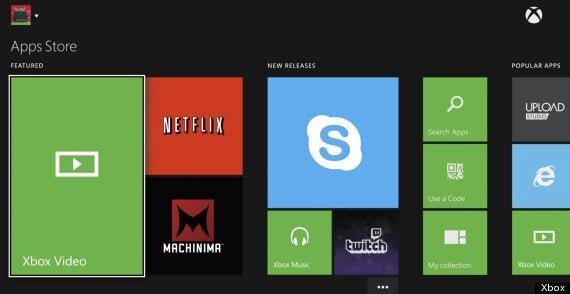The Xbox One, like any new console at launch, is potential energy in a box.
There is just no way to know what kind of evolution the machine, its games and the services that run on it will go through - or what you'll think 'Xbox' means when the next-next generation rolls around in five, or seven, or 12 years time.
And again, as with any next-gen console the Xbox One's launch games probably don't do its true power justice.
But with all that in mind one thing is abundantly clear: the Xbox One today is a hugely impressive all-in-one entertainment box. It's just going to get better. And after using it for a week we have to conclude that if any company is finally going to deliver on the "reinvention of the living room" - an ephemeral ideal decades in the making - Microsoft now has the perfect machine to do it.
Here's our initial review of the Xbox One.

Design
Let's get one thing out of the way: the Xbox One isn't really a looker. It's a big, heavy black box with a few nice and subdued design touches - the glowing white Xbox logo on the front matches nicely with that on the controller and Kinect, while the isometric cooling grill is classic and classy - but it isn't designed to be placed on display. It's instead intended to be housed in your media centre, mostly forgotten about until you need to place a disc in, while providing a hopefully stable platform not prone to overheating (like the 360 was at launch). It also has a separate power brick which really is pretty enormous, and unplugged itself more than once.
The "front face" of the Xbox One is in fact the controller and the new (included) Kinect camera and audio sensor, both of which you'll see far more than the actual Xbox. Both are similarly restrained in design, but also have more subtle, mature elements which add up to an expensive feel. The controller is excellent in the hand, with a "thinner" feel than the old gamepad, nice textured ribbing on the analog sticks and thoughtfully placed buttons. Aesthetically, the new Kinect is also more grown up than the original: a bit thicker and heavier than the Kinect 1, but without the awkward motorised moving parts and with a more permanent feel.

Initial Set-Up
Setting up the Xbox One is easy. Plug in the power, Kinect and HDMI-out cable, plug in an HDMI source (Sky TV, for instance) to the HDMI-in and turn it on. During the initial process the Xbox will figure out how to control your TV, including its volume controls and on-off function, as well as download any and all updates required by Microsoft. Our console was part of a pre-release programme and so your experience will be different to ours, but most of the updates seemed of a manageable size.
Once you're set-up you'll have the option to log into Xbox Live. You can use the same credentials as you had on the Xbox 360 (which will import your avatar, achievements and other applicable profile details) or set-up a new account. The idea is that each player in the house sets up their own account, which is less fiddly than it sounds as the Kinect is able to detect who's playing at any one time, and sign-in automatically.
Xbox TV
One of the best and most obviously impressive features of the Xbox One is its ability to accept an HDMI signal from a TV box, Apple TV, Roku or even (though this isn't recommended by Microsoft) another games console, and run this signal though its TV app. The idea is to integrate the Xbox as the layer "above" your TV, so that you can switch between games and Sky Sports without having to switch HDMI ports - or even do both simultaneously.
The connection process is simple, as described above. And the experience is pretty great too. The video is lossless, doesn't impact on the console's speed, and looks good in both full screen and when "snapped" to the side. The ability to integrate TV into the platform brings many benefits - Skype and other apps are now "right there" even on non-smart TVs, while being able to control the volume with your voice is also neat (when it works, see below). You still navigate the media box with your existing remote, and you can't "see" the Xbox layer until you want to.
The downsides are also obvious: you can't watch TV if your Xbox is off, you can't play games "off screen" like you can with the Wii U or PS4, and the potential of the Xbox "OneGuide" - designed to build interactive listings of both TV and apps to integrate both types of service - isn't available in the UK for TV services yet.
Xbox Software and OS
The heart of the Xbox One is the platform OS, which features the same tile-based grid organisation as Windows 8 and Windows Phone - and runs with many of the same principles in mind. We found it a pretty elegant and simple OS, with the potential to get even better after launch.
The basic structure is simple. Your homescreen shows your last-used game, app or movie in the centre, with other recently-used functions around the edge (along with a rolling list of 'What's New On Xbox' and challenges issued by your friends. Swipe to the left, either by "pulling" with Kinect or on your controller, and you get a grid of your 'pinned' items, which can be any combination of games, apps or media files. To the right is the selection of stores - Movies & TV, Music, Apps and Games.
It's worth nothing though that many of the apps included in the OS - even the Blu-Ray player app - weren't pre-installed in our experience. You have to download them to run them. And some of the apps - Netflix, for instance - were not ready to use during our test.
The real power of the Xbox One OS isn't its horizontal screens, though, it's the ease with which you're able to navigate between functions using both your voice and the controller. Microsoft's pre-release software videos illustrated an absurdly fast process of switching from games to TV to settings and Skype and back (say "Xbox go to TV" for instance) and "snapping" apps to the right of the screen while your main game or video plays on the left ("Xbox snap Bing"). It was almost too good to be true. But the good news is that… it wasn't. It really is that fast. We were able to switch from Dead Rising 3 to Skype in less than a second, snap Bing and run an internet search during a call and then switch back to killing zombies in a totally seamless and intuitive way. It's pretty astonishing, and a great delivery on what seemed like a stupidly ambitious goal just six months ago.
Kinect
One of the most impressive technical features - but most uneven performance elements at launch - is the new Kinect sensor.
Ten times more accurate than Microsoft's last motion control camera, the 1080p Kinect 2 is capable of distinguishing between the individual joints of six people, can tell who's speaking when, and can even read your heartbeat from how your face is blushing. It's amazing tech, and its potential use in new video games is really inspiring - if developers take advantage.
What Kinect can't quite do yet is accurately read your voice 100% of the time. Don't get us wrong - most of our attempts to ask the Xbox to search for something online, switch to the TV or load a game were successful. But those few times when it didn't work, especially when we were sat on the sofa with someone else, weren't just frustrating, they were embarrassing. As with Google Now or Siri, the aim is to save time. But having to ask Xbox twice to do something, or just revert to using your controller, actually wastes time, and makes you look a bit silly. This could improve over time, but it's a little bit of a let down after the really impressive demos and undeniable technical improvements.
All that said, being able to turn Xbox on or off with your voice, issue commands during games like Dead Rising 3 and Ryse: Son of Room and use Xbox Fitness with accurate heart-rate tracking is all really impressive - and much better than with the original Kinect.

Xbox Games
The technical specs of the Xbox One are rock-solid (eight-core processor, 853MHz GPU, 8GB RAM, 500GB hard-drive). And in our extensive play-tests of its key launch titles, it's clear this is a huge step-up with potential for some really exciting advancements through its lifetime - particularly the idea of cloud processing for AI.
There's been lots of talk about Xbox One's performance compared to PS4 at launch, including the use of 720P for games like Call of Duty: Ghosts which are 1080P on PS4. In reality we found it hard to discern too many differences between the two versions of that particular game, and we don't think the graphical differences will be that important for several years yet, if ever. Several of the launch games - Forza 5 in particular - are visual feasts, though that title is still under embargo.
Here are the individual reviews for the launch games we've covered so far:
Aside from the actual gameplay and graphics, there are some key features to note.
- The Xbox One installs games by default, and this can take some time with big titles like Forza 5 and Dead Rising 3. As with the PS4, you can start playing a game before the installation is complete once a neat little notification pops-up.
- Xbox One is not backwards-compatible. It won't play Xbox 360 discs or downloads.
- You still have to play a boxed game with the disc in the machine, even after installation.
- The Xbox One does get a little hot and loud when playing a game, but we don't think you'll notice with the sound on.
- The controller, as described above, is excellent - particularly the enhanced "rumble" feedback
- The included ability to record game clips on the fly is decent, but again feels a bit half-built. Say "Xbox record that" to record the last 30 seconds, or you can record up to five minutes and send it to the internet. However right now your options are limited - there's no one-touch method to get something on Facebook or Twitter. You upload via SkyDrive with Upload Studio instead - though that is admitedly a simple and easy-to-use included app.

Other Functions
The Xbox One is much more than a games console - unlike the "players"-focused PS4, that's really just one element of what the console does.
Here are some of our favourite elements and app experiences:
- Skype: the included Skype app is beautifully designed, and video performance with the new Kinect sensor is excellent. The pop-up notifications of incoming calls are pretty and not obtrusive. Though it's worth nothing that while you can multi-task while Skyping, if you play a game or watch TV it will switch to audio only. You also get 100 free Skype-to-phone minutes a month for six months with the Xbox One, which is handy.
- Internet Explorer: using the net on your TV has never been ideal, but for a quick Bing search or IMDB skim while watching TV, and calling up a walkthrough hint when you get stuck on a game, it's useful and easy to control with your voice (with the above caveats).
- Blu-Ray: the Xbox One, unlike the Xbox 360, is now a Blu-Ray player, which is a nice-to-have although (with the rise of Netflix et al) not as essential as it would have seemed a few years ago. The performance is great - the controller works well and the discs load quickly.
- Entertainment apps: this is a downside at launch - there's no Sky Go, iPlayer or many other streaming apps, and we weren't able to test Netflix before launch. This will improve over time - in 6-12 months expect the suite to fill up nicely - but it's a factor to consider if you want a streaming solution in time for Christmas. Xbox Music and Movies are also built-in and the Music suite comes with a free trial.
- Smartglass: Microsoft's 'second screen' solution for the Xbox is Smartglass, an app which runs on the devices "you already own" including iPads, Android phones and Windows Phone (natch). We havne't been able to test the new Xbox One app yet, but it promises the ability to Snap items, launch apps and games, type messages and use gesture controls in a way that might be more accurate, in a real world situation, than Kinect.
- Xbox Fitness: available in December, Xbox Fitness is a suite of free and paid exercise videos which incorporate real-time tracking of your performance through Kinect 2. We found the performance to be generally very good, and for the right user (with a taste for American workout tapes) it might be a real bonus. The downside is it's not quite as interactive as something like 2012's Nike Plus Fitness - you don't get real time feedback from the instructor - and some of the videos can be pretty pricey.
Conclusion:

The Xbox One is a hugely impressive machine, with some rough edges and half-finished elements. But the ambition is palpable. And the initial proposition is deep, well-made and cohesive. It gives you access to amazing games, Blu-Ray movies, streaming services and live TV, Skype and browsing. It opens up gesture and voice control as a genuinely useful option for the first time on a TV, and the interface is simply and carefully designed.
Yes, it feels like a platform built for expansion. And no, it isn't the finished product. Everything from the default black background, non-resizable Pins and extreme visual consistency with the Xbox 360 platform feels like a clue to the fact that Microsoft has bigger and wilder plans for the machine - plans they originally launched the product with, and since pulled back.
And yes, there are features here that not everyone is going to want to use. If you have a top-of-the-line Smart TV, for instance, you may have already integrated your Sky box or whatever into your main TV platform. Skype calling from the living room isn't everyone's cup of tea, and neither is browsing from the couch.
But taken as a whole, the Xbox One delivers from day one - and has a clear path to becoming something truly wonderful. It has better launch games than the PS4, and has Titanfall on the horizon, but it doesn't feel just like a new games console. It's much bigger than that, and more impressive. It's a first draft of the future - and if you're prepared to jump on board, you're going to find a lot to love.